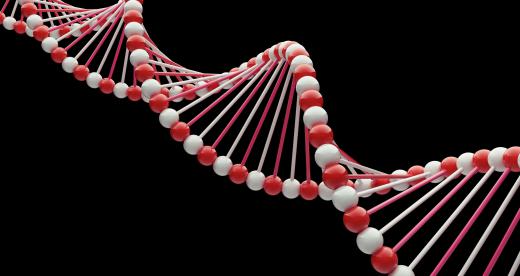What Is the Transcription Process?
The transcription process occurs within all cells and results in strands of RNA being produced. DNA within the cell provides the transcript, or blueprint, that determines the sequence of nucleotides that are joined together to make the RNA. Depending on the type of cell, transcription takes place in either the nucleus or the cytoplasm. Within eukaryotes — cells that contain membrane-bound organelles — transcription occurs in the nucleus. In prokaryotes — cells that do not contain organelles — the process takes place in the cytoplasm.
The genes found along the strands of DNA within the cell provide the code for the different proteins that the cell produces. There are two steps in protein formation, which are the transcription process and translation of the RNA that is produced. Messenger RNA (mRNA), ribosomal RNA (rRNA) and transfer RNA (tRNA) are the three types of RNA that can be produced. All three are necessary to create proteins within the cytoplasm.

There are several distinct steps involved in the transcription process, which are controlled by enzymes called RNA polymerases. To begin the transcription process, RNA polymerase binds to the DNA molecule at a specific region called a promoter. This region is found along the DNA strand before the place where the gene will be transcribed. When the RNA polymerase attaches at the promoter region, it causes the double stranded DNA to unwind and unzip so that it can move along a single strand of the molecule.
The single strand of DNA is used as the template for the sequence of RNA nucleotides that are going to be joined together to make the new strand of RNA. For each DNA nucleotide, there is a corresponding RNA nucleotide that is joined to create the RNA molecule, and both DNA and RNA contain four nucleotides. Guanine, cytosine and adenine are found within both DNA and RNA. Thymine is found in DNA only; RNA contains uracil instead of thymine.
As the RNA polymerase moves along the DNA strand, it attaches a guanine if it encounters a cytosine and vice versa. When a thymine occurs within the strand of DNA, an adenine is added to the RNA chain. Finally, when the DNA strand has an adenine nucleotide, the corresponding RNA nucleotide is a uracil. Each of the complementary nucleotides is bound to the previous ones in the chain until the final termination code is reached on the strand of DNA. At this point, the RNA polymerase breaks off from the DNA molecule, and the new strand of RNA is released.
AS FEATURED ON:
AS FEATURED ON:











Discussion Comments
This really helped my understanding of Transcription. I was having a pretty hard time understanding it when my teacher was teaching it, but now I understand. Thank you so much!
Post your comments